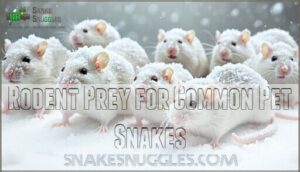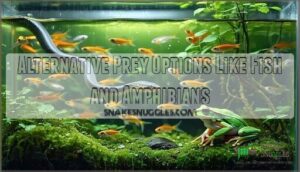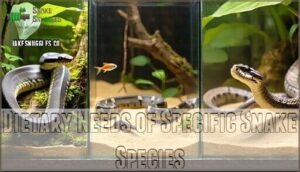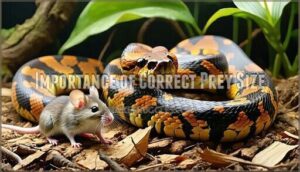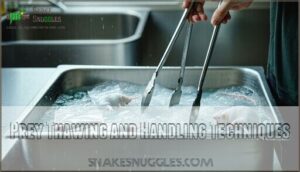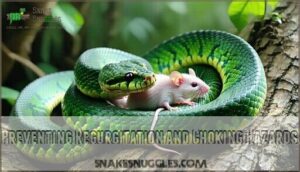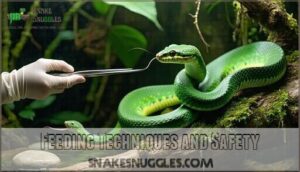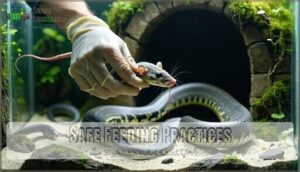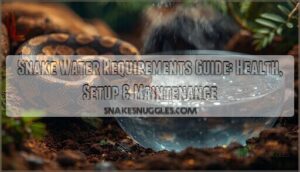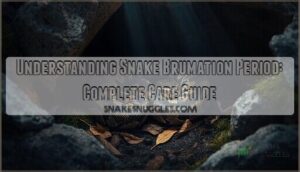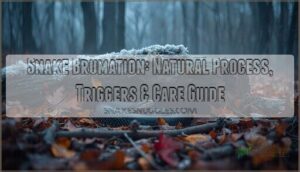This site is supported by our readers. We may earn a commission, at no cost to you, if you purchase through links.
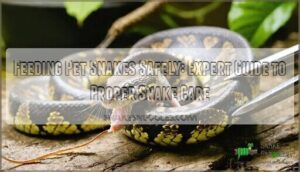 Feeding pet snakes safely starts with choosing frozen-thawed rodents over live prey to prevent injuries and disease transmission.
Feeding pet snakes safely starts with choosing frozen-thawed rodents over live prey to prevent injuries and disease transmission.
You’ll want to select prey that’s roughly the same width as your snake’s thickest part and thaw it completely before offering. Use feeding tongs to maintain distance and prevent your snake from associating your scent with food.
Feed juveniles every 5-7 days and adults every 10-14 days, then leave your snake undisturbed for 48 hours to digest properly.
The right feeding setup and timing can mean the difference between a thriving pet and costly vet visits.
Table Of Contents
- Key Takeaways
- Snake Dietary Needs
- Choosing Prey Types
- Prey Size and Preparation
- Feeding Techniques and Safety
- Feeding Schedules and Snake Care
- Safe Feeding Practices
- Frequently Asked Questions (FAQs)
- How do you feed a snake?
- Can you feed a pet snake?
- What do pet snakes eat?
- Should pet snakes eat live or frozen prey?
- How do you care for a pet snake?
- Do snakes need a lot of food?
- What is the best way to feed a pet snake?
- What not to do when feeding a snake?
- What food is toxic to snakes?
- What temperature should feeding enclosures be maintained?
- Conclusion
Key Takeaways
- Choose frozen-thawed rodents over live prey to prevent injuries, disease transmission, and parasites while maintaining nutritional value for your snake’s safety.
- Size prey correctly by selecting rodents that match your snake’s thickest body section (1-1.5x diameter) to prevent dangerous regurgitation or choking hazards.
- Use feeding tongs to maintain distance and prevent your snake from associating your scent with food, which reduces feeding aggression during routine care.
- Follow proper timing by feeding juveniles every 5-7 days and adults every 10-14 days, then leaving your snake undisturbed for 48 hours to digest safely.
Snake Dietary Needs
Your snake’s survival depends entirely on animal-based nutrition since they’re obligate carnivores who can’t process plant matter.
Whole prey delivers the complete protein, essential fats, and mineral balance your pet needs for ideal health and growth.
Animal-Based Dietary Requirements
Your snake’s survival depends entirely on animal-based nutrition—there’s no wiggle room here.
Your snake’s dietary needs aren’t negotiable—it’s whole prey or health problems.
All 3,000 snake species are obligate carnivores requiring complete animal proteins for proper growth and health.
- Zero plant tolerance: Unlike other pets, snakes can’t process any vegetation
- Whole prey necessity: Muscle meat alone causes dangerous calcium deficiencies
- Species-specific requirements: Each snake needs customized protein sources and dietary variety
- Quality matters most: Poor food quality leads to illness, stunted growth, and vet bills
Proper snake care involves understanding snake feeding techniques to guarantee a healthy diet.
Importance of Whole Prey
Whole prey serves as nature’s perfect multivitamin for your snake.
Unlike processed foods, complete meals deliver balanced nutrition through bones, organs, and muscle tissue.
This natural approach provides essential calcium, vitamins, and minerals that prekilled prey maintains.
When feeding pet snakes safely, whole foods offer superior nutrient value compared to partial meals, supporting ideal health through complete dietary balance and providing a natural source of nutrients, making them a great option for pet owners who want to give their snakes the best possible care, with balanced nutrition.
Role of Protein and Fat in Snake Diet
Protein serves as your snake’s primary building block, supporting muscle development and cellular repair through complete amino acid profiles found in whole prey.
Fat requirements vary by species, but typically constitute 10-15% of nutritional value, providing essential energy for thermoregulation and growth.
This nutrient balance from prey variety guarantees your reptile nutrition facts align with natural dietary patterns, eliminating needs for dietary supplements when following a proper snake nutrition guide to ensure a healthy and balanced diet with the right amount of whole prey.
Mineral Balance for Optimal Health
Balanced nutrition hinges on more than just protein and fat—your snake’s mineral needs determine long-term health outcomes.
Calcium needs support bone development, while vitamin supplements prevent mineral deficiency.
Whole prey naturally provides nutritional balance, but dietary variety guarantees complete nutrient balance.
Your reptile nutrition strategy should include mineral supplementation when feeding limited prey types, creating a thorough snake nutrition guide for ideal dietary needs.
Proper temperatures are needed for optimal snake digestion, which is crucial for optimal health and snake nutrition.
Choosing Prey Types
Selecting the right prey for your snake isn’t guesswork—it’s the foundation of proper nutrition that keeps your pet healthy and thriving.
Different snake species have evolved to eat specific prey types, and matching these natural preferences guarantees superior health outcomes.
Rodent Prey for Common Pet Snakes
Most pet snakes thrive on rodent prey, which provides complete nutrition through balanced amino acids and essential fats.
Mice and rats serve as the foundation for ball pythons, corn snakes, and king snakes. These rodent feeders offer convenience and safety when you understand proper prey size selection and sourcing practices.
When selecting frozen snake food, consider the benefits of frozen snake options.
- Frozen vs. Live: Frozen-thawed prey eliminates injury risks and parasite transmission while maintaining nutritional value
- Gut-loading rodents: Pre-feeding prey with calcium and vitamins enhances rodent nutrition before offering to your snake
- Prey variety: Rotating between mice, rats, and occasional chicks prevents dietary monotony and nutritional gaps
- Ethical sourcing: Purchase from reputable suppliers who maintain humane breeding conditions and proper food safety standards
Alternative Prey Options Like Fish and Amphibians
While rodents dominate most snake diets, Fish Diets and Amphibian Foods offer valuable prey variety for specific species.
Garter snakes naturally thrive on aquatic options like whole guppies and silversides. However, these alternative prey options require careful selection—avoid goldfish that contain harmful thiaminase.
Wild amphibians carry parasites and toxins, making captive-bred or frozen options safer. Fish lacks essential minerals compared to whole rodent prey, so supplement accordingly for ideal reptile nutrition.
Providing a diverse diet with prey variety options is vital for the health and well-being of pet snakes, and prey variety is key to a balanced diet.
Suitability of Bird Prey and Insect Bait
Certain bird prey options work well for specific reptiles, though they’re less common than rodents.
Chicks and quail provide higher vitamin A content, supporting skin and eye health in snakes.
Insect bait suits smaller species but requires careful prey selection to avoid wild-caught specimens that may carry parasites or toxins, which is a critical consideration.
Dietary Needs of Specific Snake Species
When choosing prey for your snake species, understanding dietary requirements becomes vital for proper nutrition.
Ball pythons and corn snakes thrive on rodents like mice and rats, while garter snakes need fish or amphibians.
Boa constrictors require larger prey as adults.
Species-specific feeding guarantees the best prey selection and maintains healthy feeding habits through proper snake nutrition guidelines.
Proper snake care involves understanding the importance of calcium balance for bone health and growth.
Prey Size and Preparation
Getting prey size right isn’t rocket science, but it’s the difference between a healthy snake and a trip to the vet.
Choose prey no larger than your snake’s widest body section—roughly 1 to 1.5 times the diameter—because too big causes regurgitation while too small leaves them hungry.
Importance of Correct Prey Size
Getting prey size right isn’t rocket science, but it’s the difference between a healthy snake and a trip to the vet.
Wrong prey size? Your snake pays the price with dangerous regurgitation or malnutrition.
Your snake’s mouth can stretch, but that doesn’t mean it should.
Choose prey no larger than your snake’s widest body section—roughly 1 to 1.5 times the diameter.
Too big causes regurgitation; too small leaves them hungry.
Prey Thawing and Handling Techniques
Once you’ve selected the right prey size, proper thawing techniques guarantee safe feeding.
Frozen prey requires patience and proper handling to prevent bacterial growth.
- Thaw in cold water – Never use microwaves that create dangerous hot spots
- Handle with clean hands – Maintain hygiene practices throughout the process
- Use feeding tongs – Grip prey behind the head for safe presentation
Store frozen-thawed prey properly and plan meals consistently for superior results.
Proper frozen prey handling is vital for the health of your pet snake.
Preventing Regurgitation and Choking Hazards
Beyond proper prey size, you’ll prevent dangerous feeding complications through careful timing and technique.
Never feed during shedding cycles, as snakes often refuse food and may regurgitate later. Wait 24-48 hours after feeding before handling to avoid stress-induced regurgitation.
| Risk Factor | Prevention Method | Warning Signs |
|---|---|---|
| Oversized prey | Choose prey 1-1.5x snake’s widest body section | Snake struggles, jaw dislocation |
| Feeding during shed | Check for cloudy eyes/dull skin before feeding | Refusal to eat, defensive behavior |
| Premature handling | Wait 24-48 hours post-feeding | Visible food bulge, defensive posture |
| Temperature shock | Verify prey reaches room temperature | Regurgitation within hours of feeding |
Proper Food Storage and Meal Planning
After you’ve handled regurgitation risks, focus on food safety and smart prey storage.
Proper nutrition planning starts in your freezer, not just the feeding tub. Stick to these snake feeding tips:
- Store frozen prey in airtight bags to prevent freezer burn.
- Schedule regular meal planning for consistent feeding routines.
- Label prey with dates for reliable reptile food safety and pet snake care, ensuring proper nutrition planning.
Feeding Techniques and Safety
You’ll choose from three proven feeding methods that balance safety with your snake’s natural instincts.
Each technique offers distinct advantages, from reducing stress to preventing feeding aggression during routine cage maintenance.
Common Feeding Methods and Their Advantages
Once you’ve prepared proper prey, you’ll need to choose the right feeding method.
Three primary snake feeding techniques offer distinct advantages: cage feeding provides minimal stress, separate container feeding prevents territorial behavior, and tong feeding stimulates natural hunting instincts.
Each method supports healthy digestion patterns while prioritizing snake feeding safety.
Your choice depends on your snake’s temperament and feeding response.
Understanding proper prey selection guidelines is essential for a successful feeding strategy.
Using Tongs to Mimic Natural Prey Movement
Grasping feeding tongs correctly transforms mealtime into natural hunting behavior for your snake.
You’ll want to grip the prey behind its head and create subtle, lifelike movements that trigger your pet’s predatory instincts.
This tong handling technique encourages natural behavior while maintaining feeding safety.
Proper prey movement stimulates reluctant eaters and makes feeding techniques more engaging for both you and your snake.
Preventing Feeding Associations and Reducing Stress
Establishing clear routines prevents your snake from treating every cage opening as dinner time.
Consistent feeding environments and handling techniques help distinguish between feeding and routine care, reducing defensive strikes and snake feeding stress.
Key stress reduction strategies:
- Use feeding tools like hooks to signal food versus handling interactions
- Maintain predictable schedules to create secure, low-stress feeding environments
- Provide adequate hiding spots for post-meal security and stress reduction
Dedicated Feeding Containers and Tools
Feeding containers and tools make snake care cleaner and safer.
Use feeding tubs to contain messes and prevent substrate ingestion. Feeding tongs let you safely offer prey without risking bites.
Snake hooks help position your snake during feeding preparation. Store feeding trays and hygiene tools separately from regular equipment to prevent contamination and maintain proper food storage protocols.
Proper snake feeding requires suitable snake feeding equipment to guarantee a healthy environment with proper food storage and the right feeding equipment.
Feeding Schedules and Snake Care
Your snake’s feeding schedule isn’t just about timing—it’s the foundation of their health and your peace of mind.
Consistent schedules paired with proper post-feeding care promote healthy digestion while preventing stress-related complications that could land you at the vet’s office, ensuring a smoother experience for both you and your pet through proper care.
Establishing a Feeding Schedule for Pet Snakes
You’ll find that creating consistent meal timing isn’t guesswork—it’s about matching feeding frequency to your snake’s age and species.
Hatchlings need meals every 5-7 days, while adults thrive on 10-21 day feeding cycles.
Ball pythons follow different digestion patterns than corn snakes, so species-specific feeding schedules matter.
Age-based feeding prevents overfeeding and supports proper snake nutrition throughout their development, which is crucial for their health and relies on understanding the importance of proper snake nutrition.
Leaving Snakes Alone After Feeding
After your snake finishes eating, resist the urge to handle or disturb them for at least 24-48 hours.
Post Feeding Care requires patience—Snake Digestion is a delicate process that demands Snake Relaxation.
Handling stress during Digestion Time can trigger regurgitation, undoing your careful feeding routine.
Think of postfeeding behavior as your snake’s "do not disturb" sign for proper Feeding Recovery and snake feeding safety.
Ensuring Proper Enclosure Conditions
Ideal conditions create the perfect snake habitat safety foundation for successful feeding and digestion.
Temperature Control between 75-85°F, proper Humidity Levels at 50-60%, and appropriate Lighting Conditions help your snake process meals efficiently.
Guarantee adequate Enclosure Size, proper Ventilation Systems, and maintain cage hygiene to support healthy snake digestion in their feeding environment, ensuring a safe and efficient digestion process.
Monitoring Snake Behavior and Adjusting Feeding Methods
Your snake’s body language tells you everything about their feeding success.
Watch for behavioral signs like tongue flicking, positioning changes, and feeding response patterns that indicate hunger or stress.
Snake observation reveals when appetite stimulation techniques work best, while digestion monitoring helps you adjust snake feeding methods for ideal snake feeding safety and monitoring snake health.
Safe Feeding Practices
Safe feeding practices protect both you and your snake from potential health risks and accidents.
You’ll need to maintain strict hygiene protocols and recognize warning signs that could indicate feeding problems before they become serious issues, which is crucial for safe feeding.
Avoiding Toxic Foods and Prey
Toxic prey poses serious health risks that you can’t afford to ignore.
Never offer wild-caught amphibians, fireflies, or insects to your snake—these contain dangerous toxins that cause food poisoning or death.
Stick to reputable commercial suppliers for safe feeding and proper prey selection to prevent contamination from toxic substances.
Preventing Cross-Contamination and Maintaining Hygiene
Proper Clean Handling prevents cross contamination between feeding sessions and protects your snake’s health.
You’ll need dedicated Feeding Safety tools, proper Sanitation Methods, and smart Safe Storage practices to minimize Contamination Risks.
Here’s your essential Hygiene Practices checklist:
- Wash hands thoroughly before and after handling prey or feeding equipment
- Use separate tongs and containers exclusively for snake feeding to prevent cross contamination
- Disinfect feeding surfaces with reptile-safe cleaners after each meal
- Store frozen prey properly in sealed containers away from human food
- Clean feeding environment regularly including water bowls and hiding spots
These Snake Feeding Precautions create a safer Feeding Hygiene routine that protects both you and your pet from harmful bacteria.
Observing Snake Behavior to Ensure Safe Feeding
Reading your snake’s behavior tells you everything about safe feeding success.
Watch for feeding cues like tongue flicking and active movement, which signal readiness.
Stressed snakes show defensive posturing or hiding—skip feeding until they’re calm.
Natural behavior patterns guide your observation skills, helping you recognize appetite stimulation versus anxiety.
Proper behavioral signals assessment prevents feeding accidents and promotes stress reduction through timing.
Understanding proper snake feeding techniques is essential for a healthy and stress-free feeding experience.
Frequently Asked Questions (FAQs)
How do you feed a snake?
Choose frozen-thawed prey matching your snake’s widest body section. Use feeding tongs to offer the prey, mimicking natural movement. Feed in their enclosure and avoid handling for 24-48 hours afterward.
Can you feed a pet snake?
Like tending a garden, you’re nurturing life through careful sustenance.
Yes, you can feed pet snakes—they’re obligate carnivores requiring whole prey like frozen-thawed mice or rats matched to their body size for ideal health, as they are careful sustenance.
What do pet snakes eat?
Pet snakes eat whole prey like mice, rats, chicks, and fish depending on their species.
You’ll choose prey that’s appropriately sized—matching your snake’s widest body section—to prevent regurgitation or choking issues.
Should pet snakes eat live or frozen prey?
Frozen-thawed prey is safer than live prey, eliminating injury risks from bites and reducing disease transmission. You’ll find it’s more convenient and cost-effective for feeding routines.
How do you care for a pet snake?
Picture your snake coiled peacefully in its terrarium—proper care starts with maintaining consistent temperatures between 75-85°F.
Providing fresh water, feeding appropriately-sized frozen prey every 1-2 weeks, and creating secure hiding spots for comfort are essential aspects of this care.
Do snakes need a lot of food?
Snakes don’t eat much compared to other pets.
You’ll feed most adult snakes only once every 1-2 weeks, while juveniles eat more frequently.
Their slow metabolism means they’re actually quite economical to feed long-term.
What is the best way to feed a pet snake?
Ninety percent of pet snake health issues stem from improper feeding techniques.
You’ll want to use frozen-thawed prey that matches your snake’s widest body section, then feed using tongs or dropping directly into their enclosure for safety.
What not to do when feeding a snake?
Don’t feed oversized prey that exceeds your snake’s widest body section—it causes regurgitation. Never use microwaves for thawing, handle snakes immediately after feeding, or ignore proper hygiene practices.
What food is toxic to snakes?
One goldfish died within hours of eating chocolate—imagine that same toxicity hitting your snake’s delicate system.
Never feed chocolate, caffeine, alcohol, onions, garlic, or avocado to snakes.
These foods cause organ failure, neurological damage, and death in reptiles.
What temperature should feeding enclosures be maintained?
Maintain your feeding enclosure’s temperature between 75-85°F, matching your snake’s normal habitat requirements. You’ll prevent digestive issues and guarantee your snake processes its meal properly without stress.
Conclusion
Safe snake sustenance starts with selecting suitable prey and proper preparation techniques.
You’ve learned that feeding pet snakes safely requires frozen-thawed rodents, correct sizing, and appropriate timing intervals.
Your feeding schedule should match your snake’s age and species requirements while maintaining sterile conditions.
Remember that consistent application of these evidence-based practices protects both you and your serpent companion.
Master these fundamentals, and you’ll guarantee your snake thrives throughout its captive life.
- https://www.chewy.com/education/reptile-and-amphibian/snake/what-do-snakes-eat
- https://www.aquariumindustries.com.au/wp-content/uploads/2015/03/A-Guide-to-Feeding-Reptiles.pdf
- https://www.petmd.com/reptile/nutrition/what-do-pet-snakes-eat
- https://www.northgateveterinary.com/site/blog/2022/06/15/what-snakes-eat
- https://www.msdvetmanual.com/management-and-nutrition/nutrition-exotic-and-zoo-animals/nutrition-in-reptiles

